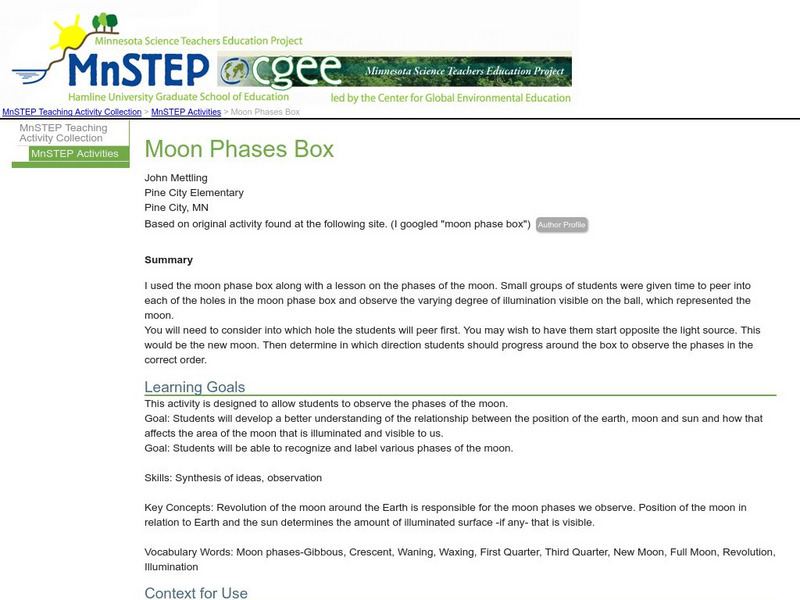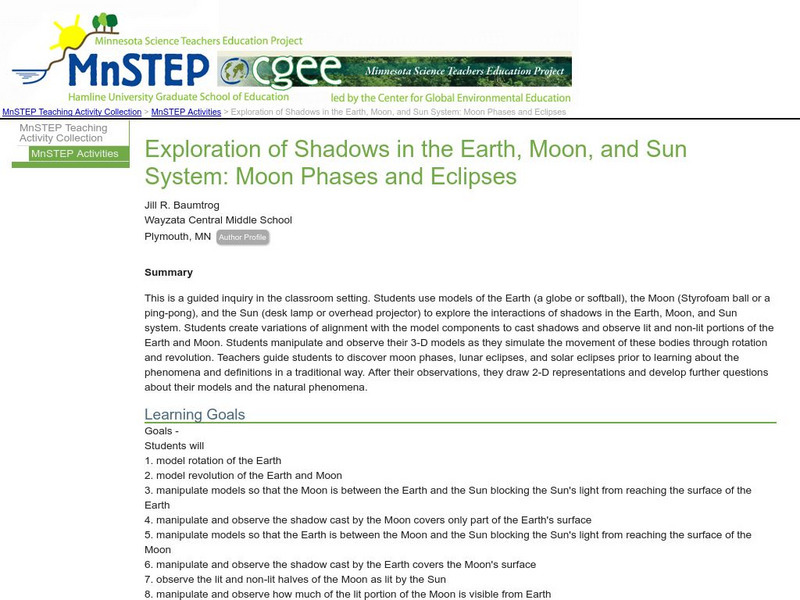Hi, what do you want to do?
Curated OER
Using Electricity
Students name appliances that use electricity. They construct a simple electrical circuit. They predict whether a circuit work. They name components of an electrical circuit.
Curated OER
Thunderstorms
Fourth graders investigate the attraction between two different charges to explain the concept of lightning in a thunderstorm.
Curated OER
Changing circuits
Students identify that there are conventional symbols to represent the components in circuits. Students use these symbols to draw diagrams of circuits. They are reminded that electric circuits can be drawn in diagrams using symbols. ...
Curated OER
Changing Circuits
Students observe an on-line activity to review the basics of electrical circuitry, then research answers to related questions on-line.In this lesson on changing components in a series circuit, students discover how different components...
Curated OER
How We See Things
Students explain that when a beam of light is reflected from its surface, it changes direction. In this virtual science experiment lesson plan, students complete an activity that requires them to investigate how flat mirrors reflect...
Curated OER
Eclipse: An Introduction
Students write journal entries about eclipses with a focus on solar eclipses.
Curated OER
Pluto
In this planet science worksheet, students learn 6 facts about the planet Pluto. Students then read a short paragraph about the planet.
Curated OER
Uranus
In this planet science instructional activity, students learn 6 facts about the planet Uranus. Students also read a paragraph containing more information about the planet.
Curated OER
Mercury
In this planet science learning exercise, students learn 7 facts about the planet Mercury. Students also read a short paragraph about the planet.
Curated OER
Energy
In this energy instructional activity, students complete a crossword puzzle by determining the terms associated with the 20 given clues. Students review alternative forms of energy in this instructional activity.
Curated OER
Air Pressure
Fourth graders observe a demonstration experiment showing air pressure. They explain air pressure by completing the worksheet.
Curated OER
Weather Poems
In this weather worksheet, learners use the pictures illustrated to help them unscramble each word to learn a few weather sayings. Then they identify the ways in which meteorologist tracked weather before technology.
Curated OER
Solar System
For this Solar System worksheet, 5th graders demonstrate knowledge of parts of the Solar System. Students unscramble letters to list these parts.
Curated OER
Cool, Clear Water - Or Is It?
Students use a problem solving method to offer a solution to one of the water quality problems within the Kansas Lower Republican River Basin. Groups research a problem area, then produce a skit, poem, song or story to illustrate the...
Curated OER
Micro-organisms
Students examine how micro-organisms are living organisms that are often too small to be seen. They explain that micro-organisms may be beneficial or harmful.
Curated OER
How We See Things
Students explain that mirrors reflect light. They examine how when a beam of light is reflected from a surface, its direction changes.
Curated OER
Changing Circuits
Students participate in an online lesson to explain how to make bulbs brighter or dimmer in a series circuit by changing the number or type of components.
Utah Education Network
Uen: How Big Are Earth, Sun, and Moon?
Understand where the sun is in the solar system and how big the earth, moon, and sun are.
University of Colorado
University of Colorado: Ph Et Interactive Simulations: Gravity and Orbits
An interactive simulation that teaches about gravitational force, circular motion, and astronomy by manipulating the sun, earth, moon, and a space station to observe the effects of gravity and orbital paths. This simulation can either be...
University of Colorado
University of Colorado: Ph Et Interactive Simulations: Gravity and Orbits
Move the sun, earth, moon, and space station to see how it affects their gravitational forces and orbital paths. Visualize the sizes and distances between different heavenly bodies, and turn off gravity to see what would happen without it.
CK-12 Foundation
Ck 12: Fifth Grade Science: Earth Science: The Sun Earth Moon System
[Free Registration/Login may be required to access all resource tools.] Discusses solar and lunar eclipses, the phases of the Moon, and why the phases occur.
E-learning for Kids
E Learning for Kids: Egypt: How Do the Sun, Moon and Earth Revolve Around Each Other?
Omar helps his parents sell things at the market. Join him while he learns about the relationship of the Sun, Moon, and Earth.
Science Education Resource Center at Carleton College
Serc: Moon Phases Box
This activity is designed to allow learners to observe and recognize the phases of the moon. They will develop a better understanding of the relationship between the position of the earth, moon and sun and how that affects the area of...
Science Education Resource Center at Carleton College
Serc: Exploration of Shadows: Earth, Moon, Sun System: Moon Phases Eclipses
A guided inquiry where students participate in the simulation of moon phases and eclipses.
Other popular searches
- Earth Sun and Moon
- Earth, Sun and Moon
- Sun, Earth and Moon
- Moon Earth and Sun Rotations
- Moon, Sun and Earth
- Earth, Sun, and Moon



























